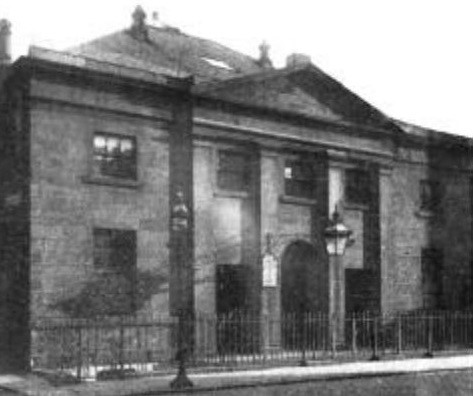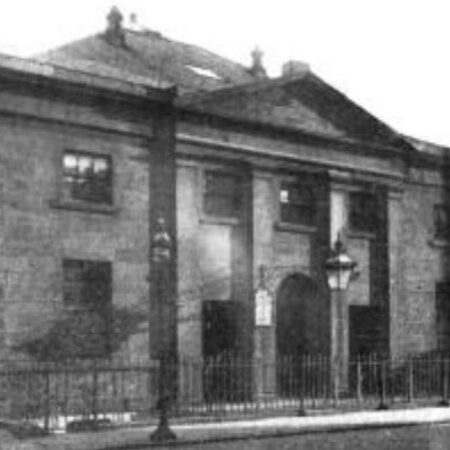Of his latest article about Scottish church history, Paul James-Griffiths of Christian Heritage Edinburgh writes, “For the next 10-12 weeks we will cover the period from the Rose St Revival in Edinburgh to the last Billy Graham Crusade in Scotland.“

Image: Charlotte Chapel on Rose St, Edinburgh, where the revival began. Today’s congregation is in a different building, in 58 Shandwick Place. Photo from Beautiful Feet.
As the new century dawned, there was a growing longing for another Christian revival and awakening in Scotland. Then, at the end of 1904, news started filtering out about a revival in Wales, which would eventually spread from there to five continents. Keen Scottish Christians travelled over to Wales to investigate what was happening and returned with glowing reports of lives deeply transformed and many being converted to Christ. Hope was stirred in Scotland for another movement of the Holy Spirit and many began praying earnestly to God.
As 1905 opened up, so did the expectancy of thousands of praying Christians in the nation. They were not disappointed: the rain of the Holy Spirit began to be poured out in different parts of Scotland. In January that year, Glasgow was impacted by God. Between 1905 and 1907 the fire of God leapt from place to place, particularly in the central belt, as the Welsh and Scots worked together for the gospel. Deep works were accomplished, especially in places like Motherwell, Cockenzie, a fishing village, and Charlotte Baptist Chapel in Edinburgh. It is this latter location which I have decided to briefly cover.
Although Charlotte Chapel had been previously impacted by the revivals of 1859 and 1873, by the time the beginning of the twentieth century emerged, there was a sense of despondency. The membership was 108, but in reality, only about 45 people actually attended the services. There were even murmurings about closing the church down because of lack of numbers, a dilapidated building, and the rise of drunkenness and immorality on Rose St where the church was situated in Edinburgh. However, some of the church members had a dogged determination not to give up, but to press on for breakthrough. The church secretary, Andrew Urquhart, was convinced that revival was coming. One time he said to his son, “Don’t you see the crowds flocking into the church?” Urquhart saw with the eyes of faith, whilst others doubted. When the elders decided to invite Revd Joseph Kemp to be their pastor in 1901, Urquhart wrote in his letter to him: “One should never venture to prophesy, but I feel almost inclined to do so and to say that you will, by God’s help fill Charlotte Chapel inside of eighteen months and that it will be, after the first month or two, a centre of evangelical life in Edinburgh and increasingly a birthplace of precious souls.” This is exactly what happened.
Kemp began his ministry there in 1902, and being inspired by Dr Andrew Murray of Scottish heritage in South Africa, he called the chapel Christians to fervent and sacrificial prayer. Beyond this, he set up regular open-air preaching on the corner of South Charlotte St and Princes St, and began a School of Bible study to train people in Christ. The chapel became a hub of gospel activity, but then Kemp went through a period of ill-health in 1905, and went to convalesce in Bournemouth. Hearing about the Welsh revival, he decided that he would be more refreshed and renewed in the presence of the Holy Spirit there. He was so inspired in Wales that he returned a different man, wanting to be obedient to the prompting of the Holy Spirit. On his return passionate, fervent prayer meetings erupted in the chapel every night for a year. People began to flock there, as moths to a light. He wrote: “I have yet to witness a movement that has produced more permanent results in the lives of men, women and children…. The people poured out their hearts in importunate prayer…. Under these influences the crowds thronged the Chapel, which only three years before maintained a ‘sombre vacuum’. After the first year of this work, we had personally dealt with no fewer than 1,000 souls. Who had brought it? God, during the prayer meetings.”
Many described the movement of God as being marked by a strong presence of the Holy Spirit, soft consciences towards Christ and one another, and grief at any sin, no matter how small. This miraculous work continued into 1906 and 1907. Kemp described a prayer meeting on 21 December, 1906: “the fire of God fell. … There was nothing, humanly speaking, to account for what happened. Quite suddenly, upon one and another came an overwhelming sense of the reality and awfulness [awesomeness] of His presence and of eternal things. Life, death and eternity seemed suddenly laid bare. Prayer and weeping began, and gained in intensity every moment…”
By February 1907, the revival began to wane. Although there were 609 members in Charlotte Chapel (a growth from 45), Tom Lennie in his book Glory in the Glen (p.125) states that of those converted to Christ during the revival period of 1905-1907, less than one in four became members there. Since that time, Charlotte Chapel has continued to be a stronghold of evangelical preaching and one of Edinburgh’s largest congregations. May revival come again!
“Repent therefore and be converted, that your sins may be blotted out, so that times of refreshing may come from the presence of the Lord…” (Acts 3:19, NKJV).

0 Comments